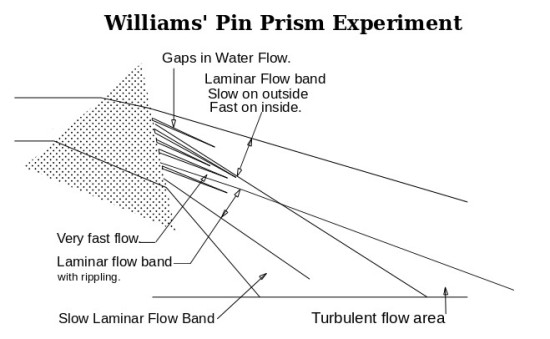-
Williams’ Pin Prism, and Fraunhofer Lines.
Posted on November 5th, 2014 No commentsI am sorry, but the spectroscope does not indicate any atomic information about a material. As a comparator it is a very useful tool but only in tightly controlled conditions.
It does not tell you the atomic structure of a distant object, nor does it tell you the atomic structure of an object held within the spectroscope equipment itself.
The Pin Prism.
I carried out these experiments in 1990. My idea was to look at the mechanics of the prism. I know that most people will say that a prism is just a triangular piece of glass and that a slit is just a rectangular hole but, individually, they change light. The slit creates the colours and the prism creates the spectrum. Working together, they become a mechanism.
Basically, the Pin Prism is (was, the water rapidly destroyed it) a triangular array of pins. The original one consisted of brass ‘panel pins’ hammered into a plastic coated plywood board. The array quality was rather erratic because hammering pins into this material is very difficult when trying to get them at 3mm centres. There were other problems in getting the experiment working, but I will discuss them later. (Note; I carried out similar experiments with a ‘Pin Lens’ and a ‘Pin Sheet’ that also gave quite good results considering the poor quality of the equipment.) Note; You obviously do not need to spend £millions of public money to carry out physics research.
Most of the results roughly matched the comparison with the light experiments i.e. where the ‘Yellow and Cyan ‘ bands overlapped the water was very turbulent, and the ‘Yellow and Red’ areas plus the ‘Blue’ areas were fairly smooth.
However, I finally noticed that were various gaps in the flow. Initially I was just intrigued and carried on experimenting, varying the flow rates and noting what happened. I noticed that the gaps lengths extended with increase in flow rate.
As the flow rate dropped the gap diminished until it disappeared. As the flow reduced even more, a ‘ridge’ formed, caused by the water that was originally on both sides of the gap combining. Therefore the water flow changed from a gap to a ‘pressure ridge’.
With a fixed experimental set-up with light, if we start off with a high energy light source, sufficient to produce black lines in the spectrum, and slowly reduce the energy , the gaps in the flow (black lines) will reduce in width and length until the gaps (black lines) disappear.
If we continue reducing the energy level, bright lines will develop to replace the dark lines. If the original black line was in an area of the spectrum that was red, then a brighter red line would develop.
What causes the gaps in the spectrum on which so much physics research is based?
The answer is, the same mechanics that cause the gaps in the pin prism. The water flowing through the pin prism follows a very complex path. On entering the prism it is split into a number of streams by the first pins. Whilst passing through the prism it is split or combined on numerous occasions before exiting the prism.
If the angle at which the water enters the pin prism is constant then the paths followed by the individual streams will tend to be constant.
The speed of any particular stream of water will depend on the energy loss due to the length of the path taken.
With light the same mechanics apply. The atoms of glass act like the pins in the pin prism. The various streams of light are split or combined thousands of times before the light exits the prism.
See also “Goethe’s Colour Spectra”
Author – Brian Williams
Abstract from Physics or Fantasy – Section 2 – Colour and The Quantum Theory


